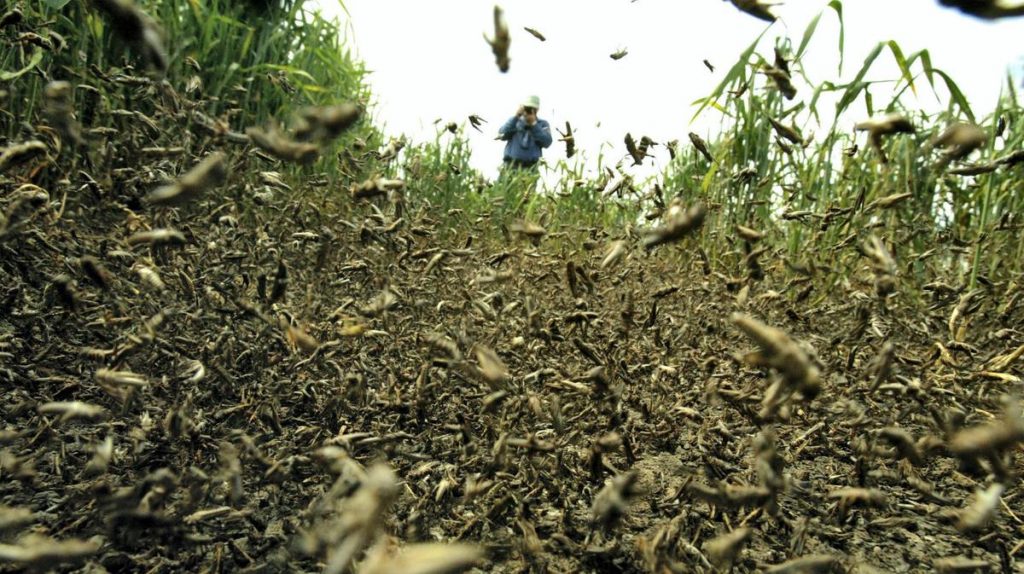Massive swarms of locusts are bearing down on Saudi Arabia and Egypt as they spread rapidly along the shores of the Red Sea, the United Nations has warned. Breeding along the coasts of Eritrea and Sudan, the swarms are spreading farther afield, with at least one having crossed over the Red Sea to Saudi Arabia in mid-January and more a week later. Swarms also went north along the Red Sea towards Egypt.

The UN is calling on countries in the flight path to step up vigilance and take precautions.
“Good rains along the Red Sea coastal plains in Eritrea and Sudan have allowed two generations of breeding since October, leading to a substantial increase in locust populations and the formation of highly mobile swarms,” the UN’s Food and Agriculture Organisation said on Friday.
Adult locusts can eat their body weight in fresh vegetation every day and the FAO warned that even a small swarm can eat enough food for 35,000 people in just 24 hours.
A female locust is able to lay around 300 eggs in her short life, meaning swarms can measure miles wide and be made up of hundreds of millions of individuals. They can strip the land bare as they fly through.
Tackling swarms is also made difficult because they are highly mobile and able to fly up to 150 kilometres a day.
The FAO is planning to hold a meeting in Jordan next week to discuss measures to tackle the spread and how to assist affected countries.
“The devastating impact locusts can have on crops poses a major threat to food security, especially in already vulnerable areas,” the FAO said.
The issue of higher breeding is not only confined to Eritrea and Sudan. Rains from cyclones Mekunu in May and Luban last October triggered a mass breeding of locusts in Saudi Arabia’s Empty Quarter, near the Yemen-Oman border.
Hatching was also recorded around the villages of Thuwal and Masturah, south-west of Medina on the kingdom’s west coast.
The UN agency said a few swarms from two generations of breeding had reached the UAE and as far as southern Iran. However, with no signs of slowing, swarms could reach the India-Pakistan border if unchecked.
“The next three months will be critical to bringing the locust situation under control before the summer breeding starts,” said Keith Cressman, the FAO’s senior kocust forecasting officer.
“The further spread of the current outbreak depends on two major factors – effective control and monitoring measures in locust breeding areas of Sudan, Eritrea and Saudi Arabia and the surrounding countries, and rainfall intensity between March and May along both sides of the Red Sea and in the interior of the Arabian Peninsula.“
Aerial spraying and ground control operations have already taken place across Saudi Arabia, Sudan, Egypt and Eritrea. So far, nearly 85,000 hectares – about eight-and-a-half times the area of Abu Dhabi island – has been treated since December, 30,000 hectares in the past two weeks alone.

Control measures are also under way in Iran after at least one swarm arrived on the southern coast at the end of January.
The outlook for February is that breeding will continue along the Red Sea coast, leading to more “hopper bands and adult swarms”.
The FAO warned that “as vegetation dries out, adult groups and a few swarms are likely to move north along the Red Sea coast”.
Such apocalyptic scenes – January 2019 in Makkah – could be increasingly seen in the next few weeks:
#صراصير_الحرم
— ياسمينآآ.❀♬? (@yasmeena_arafat) January 8, 2019
هل هذا نذيرٌ من الله ونحن في غفله!!
بعد اقامة حفلات راس السنة بمنطقة بالقرب من قبر الرسول
صراصير الليل في الحرم المكي وبعض المناطق حول مكه وكذلك الجراد الذي انتشر في البلاد
{فأرسلنا عليهم الطوفان والجراد والقمل والضفادع والدم ايات مفصلات}!!! pic.twitter.com/g3YVN2lNm7
It predicted this would largely have an impact on northern areas around the Nile Valley in northern Sudan, but there was a “moderate risk” that swarms would continue to cross the Red Sea towards Saudi Arabia and the UAE.
Mr Cressman told Reuters that the previous major desert locust upsurge was between 2003 and 2005, when more than 12 million hectares – about twice the size of the UAE – were treated in west and north-west Africa. The swarm response cost some $750 million, including food aid to affected areas.
Since then there have been numerous locust outbreaks along the coastal plains on both sides of the Red Sea, but they have mostly been controlled. How will it end this time?











